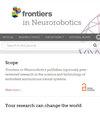EMG-YOLO: road crack detection algorithm for edge computing devices
IF 2.6
4区 计算机科学
Q3 COMPUTER SCIENCE, ARTIFICIAL INTELLIGENCE
引用次数: 0
Abstract
IntroductionRoad cracks significantly shorten the service life of roads. Manual detection methods are inefficient and costly. The YOLOv5 model has made some progress in road crack detection. However, issues arise when deployed on edge computing devices. The main problem is that edge computing devices are directly connected to sensors. This results in the collection of noisy, poor-quality data. This problem adds computational burden to the model, potentially impacting its accuracy. To address these issues, this paper proposes a novel road crack detection algorithm named EMG-YOLO.MethodsFirst, an Efficient Decoupled Header is introduced in YOLOv5 to optimize the head structure. This approach separates the classification task from the localization task. Each task can then focus on learning its most relevant features. This significantly reduces the model’s computational resources and time. It also achieves faster convergence rates. Second, the IOU loss function in the model is upgraded to the MPDIOU loss function. This function works by minimizing the top-left and bottom-right point distances between the predicted bounding box and the actual labeled bounding box. The MPDIOU loss function addresses the complex computation and high computational burden of the current YOLOv5 model. Finally, the GCC3 module replaces the traditional convolution. It performs global context modeling with the input feature map to obtain global context information. This enhances the model’s detection capabilities on edge computing devices.ResultsExperimental results show that the improved model has better performance in all parameter indicators compared to current mainstream algorithms. The EMG-YOLO model improves the accuracy of the YOLOv5 model by 2.7%. The mAP (0.5) and mAP (0.9) are improved by 2.9% and 0.9%, respectively. The new algorithm also outperforms the YOLOv5 model in complex environments on edge computing devices.DiscussionThe EMG-YOLO algorithm proposed in this paper effectively addresses the issues of poor data quality and high computational burden on edge computing devices. This is achieved through optimizing the model head structure, upgrading the loss function, and introducing global context modeling. Experimental results demonstrate significant improvements in both accuracy and efficiency, especially in complex environments. Future research can further optimize this algorithm and explore more lightweight and efficient object detection models for edge computing devices.EMG-YOLO:边缘计算设备的道路裂缝检测算法
引言 道路裂缝大大缩短了道路的使用寿命。人工检测方法效率低、成本高。YOLOv5 模型在道路裂缝检测方面取得了一些进展。但是,在边缘计算设备上部署时会出现问题。主要问题在于边缘计算设备直接与传感器相连。这导致收集到的数据有噪声、质量差。这个问题增加了模型的计算负担,可能会影响其准确性。为了解决这些问题,本文提出了一种名为 EMG-YOLO 的新型道路裂缝检测算法。方法首先,在 YOLOv5 中引入了高效解耦头,以优化头部结构。这种方法将分类任务与定位任务分离开来。这样,每个任务都可以专注于学习其最相关的特征。这大大减少了模型的计算资源和时间。它还能实现更快的收敛速度。其次,模型中的 IOU 损失函数升级为 MPDIOU 损失函数。该函数通过最小化预测边界框与实际标注边界框之间的左上角和右下角点距离来工作。MPDIOU 损失函数解决了当前 YOLOv5 模型计算复杂、计算量大的问题。最后,GCC3 模块取代了传统的卷积。它利用输入特征图进行全局上下文建模,以获取全局上下文信息。实验结果表明,与目前的主流算法相比,改进后的模型在所有参数指标上都有更好的表现。EMG-YOLO 模型将 YOLOv5 模型的准确率提高了 2.7%。mAP (0.5) 和 mAP (0.9) 分别提高了 2.9% 和 0.9%。本文提出的 EMG-YOLO 算法有效解决了边缘计算设备数据质量差和计算负担重的问题。这是通过优化模型头部结构、升级损失函数和引入全局上下文建模来实现的。实验结果表明,该算法在准确性和效率方面都有显著提高,尤其是在复杂环境中。未来的研究可以进一步优化该算法,为边缘计算设备探索更轻量级、更高效的物体检测模型。
本文章由计算机程序翻译,如有差异,请以英文原文为准。
求助全文
约1分钟内获得全文
求助全文
来源期刊

Frontiers in Neurorobotics
COMPUTER SCIENCE, ARTIFICIAL INTELLIGENCER-ROBOTICS
CiteScore
5.20
自引率
6.50%
发文量
250
审稿时长
14 weeks
期刊介绍:
Frontiers in Neurorobotics publishes rigorously peer-reviewed research in the science and technology of embodied autonomous neural systems. Specialty Chief Editors Alois C. Knoll and Florian Röhrbein at the Technische Universität München are supported by an outstanding Editorial Board of international experts. This multidisciplinary open-access journal is at the forefront of disseminating and communicating scientific knowledge and impactful discoveries to researchers, academics and the public worldwide.
Neural systems include brain-inspired algorithms (e.g. connectionist networks), computational models of biological neural networks (e.g. artificial spiking neural nets, large-scale simulations of neural microcircuits) and actual biological systems (e.g. in vivo and in vitro neural nets). The focus of the journal is the embodiment of such neural systems in artificial software and hardware devices, machines, robots or any other form of physical actuation. This also includes prosthetic devices, brain machine interfaces, wearable systems, micro-machines, furniture, home appliances, as well as systems for managing micro and macro infrastructures. Frontiers in Neurorobotics also aims to publish radically new tools and methods to study plasticity and development of autonomous self-learning systems that are capable of acquiring knowledge in an open-ended manner. Models complemented with experimental studies revealing self-organizing principles of embodied neural systems are welcome. Our journal also publishes on the micro and macro engineering and mechatronics of robotic devices driven by neural systems, as well as studies on the impact that such systems will have on our daily life.
 求助内容:
求助内容: 应助结果提醒方式:
应助结果提醒方式:


